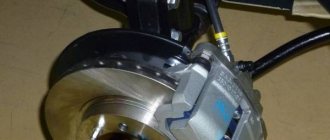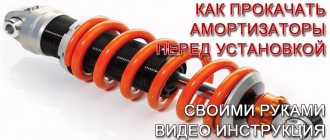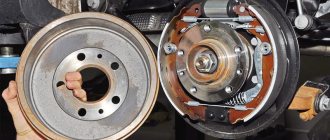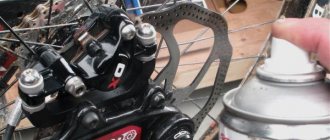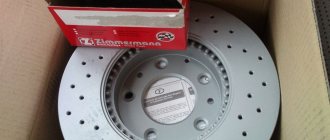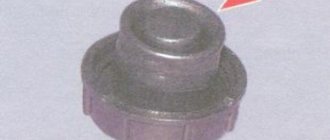ABS device
The design of the anti-lock braking system of a car's wheels assumes the presence of the following parts and elements:
- Speed sensor, acceleration/deceleration.
- Control valve. This element is located in the brake system line. The control valve is an integral part of the pressure module.
- Anti-lock braking system ECU. The main task of the ABS electronic control unit is to receive signals from the above sensors and control the operation of the valves.
What is special about bleeding anti-lock brakes?
In cars in which the hydraulic valve block, hydraulic accumulator and pump are located in one unit, the fluid is replaced and the system is pumped in the same way as on cars without ABS. However, before bleeding the ABS brakes, you need to turn off the corresponding fuse.
The process itself is as follows. Bleeding the brakes is done with the brake pedal pressed, while the RTC fitting must be unscrewed. Next, turn on the ignition and wait until the sediment expels all the air previously formed in the system. After this, the fitting is tightened and the brake pedal is released. If everything was done correctly, the inscription indicating a malfunction of the anti-lock wheel system will disappear on the instrument panel in the cabin.
How to bleed ABS brakes if the car’s hydraulic module with valves and the hydraulic accumulator are located in separate units? Here we need a special diagnostic scanner. It will read information from the ABS electronic control unit. If you do not have such a device, then it is best to bleed the brakes at a specialized service station. The same applies to cars with ESP and SBC systems - such cars can only be repaired in a car repair shop.
Brief characteristics of ABS
First, let’s briefly talk about the traction control system itself. In general, ABS is a system that performs the function of preventing wheel locking during sudden/emergency braking of the vehicle. The main task of ABS is to regulate the speed of rotation of the disks. And this adjustment occurs due to the distribution of pressure in the brake system. A separate signal (electrical pulse) is sent from each sensor, which enters the system control unit, and it, in turn, makes a decision to slow down a specific wheel at the moment the vehicle is moving. This system is very useful in winter, when the contact patch with the road surface is significantly reduced. In this case, the risk of the vehicle skidding is reduced significantly, while a car without ABS is susceptible to skidding even on dry asphalt in the summer.
How to bleed ABS brakes?
On Toyota and many other foreign-made cars, the algorithm for carrying out this work is almost the same. Therefore, the instructions outlined below can be used for any modern car (even for domestic VAZs).
So what needs to be done? To begin with, we note that the pressure in the brake system of a passenger car reaches a level of 180 atmospheres. Therefore, in order to avoid the release of liquid, it is necessary to discharge the pressure accumulator. Only after this can you begin to disconnect the brake lines. To do this, you need to press the brake pedal about 20 times.
The pumping itself is performed with an assistant. Therefore, invite a friend or neighbor to the garage in advance before performing such an operation. How to bleed ABS brakes on Kalina and Priora? First of all, turn off the ignition and disconnect the connectors on the brake fluid reservoir. After this, we begin pumping the front wheels. To do this, put the hose on the bleeder fitting, open it one turn and press the pedal all the way. It should be kept in this state for several seconds (until all the air has left the system). Then you can safely tighten the fitting and release the pedal. That's it, our front brakes are ready.
ABS device
The design of the anti-lock braking system of car wheels requires the presence of the following parts and elements:
- Speed sensor, acceleration/deceleration.
- Control valve. This element is located in the brake system line. The control valve is an integral part of the pressure module.
- Anti-lock braking system ECU. The main task of the ABS electronic control unit is to receive signals from the above sensors and control the operation of the valves.
Rear wheels
A more difficult task will be with the rear ones. Here you need to pump each wheel separately. And we'll start with the rear right. As in the first case, first we attach the hose to the fitting and unscrew it back. Next, the assistant presses the pedal all the way and turns the ignition to position “2”. Note! The brake pedal is released only after the operating pump has expelled all the air from the system. And as soon as the liquid begins to come out without bubbles, close the fitting and release the brake pedal.
The rear left wheel is pumped using almost the same principle, but there are some nuances here. How to bleed ABS brakes? On Volkswagen Passat and other foreign-made cars, you need to put on the fitting and unscrew it one turn. Next, without pressing the brake pedal, we wait until the pump removes the air-filled fluid from the system. After this, the assistant presses the pedal halfway and you tighten the fitting. That's it, at this stage you can complete the work. Everything is assembled in the reverse order - the ignition key is set to zero and connectors are connected to the brake fluid reservoir. Experts also recommend additionally checking the tightness of the system.
Replacing ABS brake fluid. List of actions and subtleties
Replacing fluids in all parts of a car is a very important process, and replacing ABS brake fluid is no exception. To be frank, replacing the brake fluid is a priority, since it’s still possible to drive on burnt-out oil, but driving a car without brakes is simply dangerous. This procedure also has its own frequency. For each brand and each model it is different and this is stated in the instructions for using the car. Average replacement rates are calculated on a regular basis of about 1-3 years, or from 30,000-40,000 km.
mileage , but do not forget that all this is generalized. The frequency largely depends on how intensively the car will work, under what conditions, and so on.
Useful tips
How to bleed ABS brakes on Priora, Kalina and Honda Civic correctly? To prevent the work from causing harm to your car, and you don’t have to take it to a car service center, you should remember a few rules. Firstly, you do not need to turn on the ignition for more than 15-20 seconds. Otherwise, this will lead to failure of the electric pump. Secondly, it is necessary to take breaks between pumping the wheels. After all the air (aired mixture) has come out of one wheel, you should not immediately move to the second. You need to wait about 5-10 minutes until the air in the system completely disappears.
Myths and legends
Replacing brake fluid with ABS often causes an abundance of all kinds of controversy among car enthusiasts. The myths associated with this liquid also add fuel to the fire.
The first is that brake fluid has an eternal life cycle. In fact, over time, the liquid may lose its prescribed qualities, since it is constantly in contact with air, which enters it through the compensation holes.
Second myth
The problem is that many people believe that it is quite common to mix liquids from different manufacturers. In reality, you can't do that. The thing is that for each type of car a composition is produced with its own characteristics and nuances.
Despite the generality of the prescribed recommendations for the production of such liquids. Mixing can be carried out only for a short period of time, and then with the condition that in the future a complete replacement of the brake fluid will be carried out.
The third myth is the most extensive. He says that liquid of the DOT-4 standard can be used for filling into any car. As for the situation in real life, no, this liquid is not universal. And here it’s worth starting only from those species that have been officially recognized by the manufacturers themselves, and not throwing away and endangering everyone and everything.
As you can see, all these things are quite refutable, and if you follow them, then the path to problems is not far.
How to remove air from the system
Since it is difficult to pump the brakes alone (you will have to run a lot, press the pedal, then use something to fix it in the depressed position), it is better to use the services of a partner. An assistant sits behind the wheel, after which he presses the pedal three to five times. This should be done quite slowly, the interval between pushes should be about one and a half to two seconds. When the assistant presses the last, fifth time, the pedal is necessarily fixed in the extreme depressed position. Please note that the pedal is held in this position until you unscrew the bleeder fitting half a turn. In this case, you will see that the liquid is flowing through the hose. There are air bubbles in it that need to be removed. After the liquid stops flowing from the tube, you need to tighten the fitting. The assistant can now take his foot off the brake pedal. This cycle of procedures is carried out until there is not a single air bubble in the liquid. And always pay attention to how much brake fluid is in the expansion tank. Do not let it drop to the minimum level. After finishing pumping one circuit, be sure to tighten the fitting and tighten the rubber cap. All other brake mechanisms are bled in a similar manner. Moreover, you can bleed the brakes on UAZ and BMW using this manual.
When is pumping necessary?
Work is carried out in the following cases:
- Replacing brake pipes.
- Replacing front disc brake calipers on a VAZ-2106.
- Replacing brake hoses.
- Installation of a new master cylinder (as well as repair).
- Replacing fluid in the hydraulic drive system.
- Installing new cylinders on the rear wheels.
- Replacing the brake pressure regulator.
If you had to get into the design of the brake system, be sure to bleed it - this will improve performance and reduce the braking distance.
Methods for bleeding brakes without outside help
After carrying out repair work on the vehicle's brake system, it is necessary to bleed the brake system drive to remove air from the system.
The traditional way to bleed brakes
But sometimes there are situations when you have to repair your car alone in the garage. And then it is necessary to pump the brakes without an assistant and without outside help. There are several ways to do this.
Sequence of bleeding brakes with gas stop
Before starting the procedure for bleeding the car's brake system, it is necessary to thoroughly clean the brake cylinder fittings from dirt and remove the rubber caps from them.
- Add (if necessary) brake fluid to the brake fluid reservoir.
- You need to press the brake pedal several times.
- Next we need a gas stop. You can use the gas stop from the hood, for example from the “tens”. Keep the brake pedal pressed. Then we install a gas stop between the pedal and the seat.
- After installation, bleed the brake fluid along with the air from the cylinder. At the moment when we bleed the liquid, the gas stop itself begins to put pressure on the pedal and pushes it to the floor.
- And so, we pump all 4 wheels until all the air is removed from the system.
- Thus, you can remove air from the system yourself.
Using a rubber syringe
You can make a simple device for bleeding brakes from scrap materials. For example, this. Place a hose of a suitable size on a regular syringe, preferably transparent. Squeeze the syringe as much as possible so that the least amount of air remains in it; the other end of the hose must be tightly placed on the fitting. Hang the syringe so that the hose is in a vertical position as much as possible.
Further pumping the brakes without an assistant looks like this: Press the pedal sharply three or four times, releasing it slowly so that excess pressure appears in the system. Then you should slightly unscrew the fitting so that air bubbles with brake fluid are drawn into the syringe. Perform this operation several times. Sometimes two or three approaches are enough. Then you need to carefully close it, remove the hose, and squeeze the liquid out of the syringe into a bottle or jar. This operation must be performed for each wheel. It is also necessary to monitor the fluid level in the brake cylinder and periodically add brake fluid.
Using a medical syringe
For the third method you will need a medical syringe. Follow the sequence of bleeding the brakes:
- We fill the syringe with brake fluid and tightly connect the medical syringe with the cap of the brake fluid tank using sealant or mechanical seals.
- We unscrew the fitting (which needs to be pumped), placing a prepared bottle under the place where the liquid leaks out.
- We press the syringe plunger and, creating pressure in the syringe, pump brake fluid into the entire braking system.
- At the outlet of the circuit that we are pumping, liquid will come out along with air bubbles.
To make sure there is no air in the brake circuit, it is necessary to push the brake fluid through the entire brake system.
Using a syringe to bleed the brake system
To do this, you will need additional brake fluid in a volume no less than the volume of the brake circuit.
With rubber tube
To bleed the car's brake system alone, a brake bleeder in the form of a hose with a check valve will help. To do this, we need a rubber tourniquet tube used to stop bleeding. We tie one end of the tube and make a 10 mm long incision at a distance of a centimeter from the dressing site. We put the end of the tube on the fitting, and lower the second one with a cut into a bottle with brake fluid. When we unscrew the fitting, when we press the pedal, the brake fluid will exit the system through a cut in the bottle. When you release the pedal, brake fluid will be sucked out of the reservoir and not from the bottle, since the cut will close, acting as a check valve. Thanks to this method, the brakes are pumped without an assistant and the brake fluid is replaced.
Sequence of bleeding brakes with compressor
This method is familiar to many, however, most prefer to torment themselves and also an assistant by pumping fluid with a pedal. To do this, you needed a clutch reservoir from a “classic” with a lid, a nipple for a tubeless tire and a vacuum corrector tube. We make a hole in the lid of the tank with a diameter of 1.3 cm and insert the nipple into it. Screw this cap onto the master cylinder reservoir.
Cover with nipple for compressor connection
We put the vacuum corrector tube on the “classic” reservoir and get a container for bleeding the brake system. And now we put a compressor hose on the nipple and apply a pressure of 0.5 atm to this unique device for pumping the brakes; if we apply more, the reservoir may not be able to withstand it and may burst. All! Now we go down under the car and calmly drain the liquid and air from the wheel cylinders. The main thing is to remember to add fluid and maintain pressure.
Instead of a compressor - a pump
At the market we buy a cover from a classic clutch reservoir and a valve, that is, a nipple. We make a hole in the lid of the required diameter and insert a valve there. We make the hole so that the valve sits tightly and does not slip off. It is also necessary to cut out the rubber seal of the lid in the middle. Now we screw this cap onto the brake reservoir and connect a regular electric pump to the valve. Now we pump up the pump to 3 atmospheres according to the pressure gauge, and then unscrew the bleeder fitting. It is also necessary to maintain pressure. The pump has a check valve that prevents air from flowing back.
Air bubbles are easier to see in transparent hoses
The pump must be turned on for no more than a few seconds, otherwise the pressure will immediately jump. After bleeding the brakes without assistance on one wheel, the pressure drops to about 2 atmospheres, so it is necessary to pump up, and if necessary, add brake fluid and bleed the remaining wheels.
If there is no compressor and pump
You can independently assemble a simple device for bleeding the brakes without a compressor and pump. Excessive pressure in the brake system is created using a conventional car bladder. We pump it up to a pressure of 0.5 atmospheres on the pressure gauge.
Bleeding brakes using a car camera
Then we attach it using any of the methods described above, or simply the most convenient one, and follow the sequence of bleeding the brakes using this method.
Video - bleeding brakes without an assistant
Conclusion!
In general, pumping brakes without an assistant turns out to be quite interesting and even more convenient than the usual way. You unscrew the fitting and a stream of pressure comes out of it, as if someone is pressing the pedal. But by pressing the pedal you can only squeeze out a small portion, and then it will water until you close it or until the brake fluid in the reservoir runs out.
It should be remembered that after completing the bleeding procedure, it is necessary to close all the brake cylinder fitting caps, and if the rubber membrane is jammed, it must be corrected. It is advisable to change your car's brake fluid every three years.


